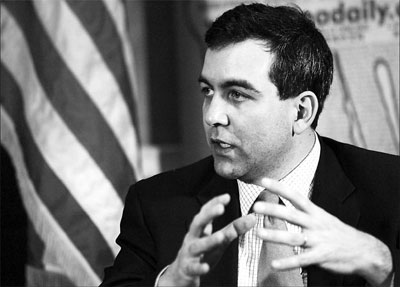Editor's Note: US Commerce Assistant Secretary David Bohigian has visited China several times in past five years. This time, he is leading the second US Clean-Energy Trade Mission to China, which comprises 17 American companies. In an interview with Zhang Xiaogang, he talks at length about the prospects of clean energy technology cooperation between the two countries. Following are excerpts:
US Commerce Assistant Secretary David Bohigian talks during an interview with China Daily yesterday. He is leading the second US Clean-Energy Trade Mission to China.
Q: What kind of result can you foresee if the US and China work together to promote clean energy technology?
A: We're here to talk about how we can provide more energy in a more efficient and cleaner manner so that we're able to reduce the intensity of greenhouse gas emissions in the decades to come.
I hope for two things. One is to continue the tremendous discussions we've had as part of the Asia Pacific Partnership on Clean Development and Climate, which includes China, India, Japan and other countries in a series of multilateral meetings and task forces to talk about deploying these technologies.
Another part of that discussion, in which China is participating, is the major economies' meeting in Washington in late 2007. It will be held again in Hawaii in just a few weeks. So those policy discussions are taking place in Beijing, Hong Kong and Guangzhou with central government officials, as well as provincial and local officials.
(We) talk about things like market-based pricing for energy, how to protect intellectual property rights so the most important innovations can enter the market. We've got many policy goals that we'll discuss, as we did this morning with the Ministry of Finance and the Ministry of Commerce (MOFCOM), and will do so with the National Development and Reform Commission (NDRC) tomorrow morning.
We're happy to have had those discussions together often in the US we say the government creates the climate for business or it helps the environment for prosperity, and that's never more true than when we're discussing the environment and climate issues.
Q: China, too, is very competitive in implementing solutions. If China and the US join hands, do you think they will set a good example for other developing countries, especially those around the Pacific rim such as India and Indonesia? Will it open the doors for US firms and Chinese engineers, and perhaps workers, to implement solutions across the world?
A: We're in no choice. If China and the US are not working together, the problems will only get worse with air and water pollution, and climate change. Our companies have the ability to work together closely with your companies. Our last trade mission in April 2007 was (incidentally) the first clean energy trade mission the US government ever led. It resulted in hundreds of millions of dollars in sales, and we believe each one of those is a design and implementation solution for both countries.
Q: Will there be more trade missions? Or, will it become more regular or institutionalized between the two countries, or several countries? Can it be tied to a bigger program?
A: Every American knows the Chinese saying that a journey begins with a single step. Today we've taken two important steps. First, having our companies here on the second clean energy trade mission has helped our countries institutionalize the process of our companies' coming together.
The second step we've taken today is opening up a dialogue on clean energy and energy efficiency. And that dialogue, along with our partners at the China Chamber of Commerce for Import and Export of Machinery and Electronic Products (CCCME), and our partners at the NDRC and MOFCOM, we certainly hope will continue. The president has prioritized working with the world through the major economies, as well as the Asia Pacific Partnership on Clean Development and Climate, and we certainly expect that to continue.
Q: Do you expect the initiatives you've taken to continue beyond this year - after the presidential election, that is?
A: I really hope it will continue in 2009 under a new president and beyond because it really has become a generational issue. This generation of policy makers and more and more voters understand the importance of these issues. I believe it is bipartisan, Republicans and Democrats seek to develop cleaner energy, and energy that doesn't have the same carbon footprint that we've had in the past. It's important that we show cooperation in trade and on clean energy.
Q: Many US clean-tech companies don't have a presence in China. Some have just come here looking for opportunities. What kind of environment are they seeking? What services do they expect China to provide? And what kind of regulatory conditions they expect?
A: US, Chinese and global companies all will benefit from some of the policy changes that China is undertaking. I'll highlight just a few. One is the market-based pricing for energy. People's ability to pay the right rate, the global rate for energy, is probably the most powerful force creating energy efficiency and new innovation opportunities in China.
Second, I would highlight the rule of law. Companies' ability to understand what they have bargained for and get the support of the court system is absolutely crucial.
And third would be intellectual property rights. But I do think China remains an enormous opportunity for both the countries. We are going to take a bus ride from Guangzhou to Hong Kong tomorrow. During that ride, we are going to see one out of 20 factories in the world (that has been) developing products. And we want to make sure the Chinese and American peoples and those in the rest of the world can use that prosperity to protect the world for their children. So it's an enormous opportunity that our partners here and the Chinese government, and with CCCME, have provided.
(China Daily January 10, 2008)






